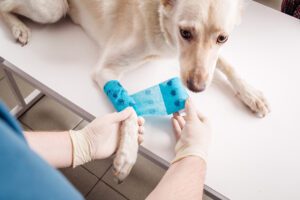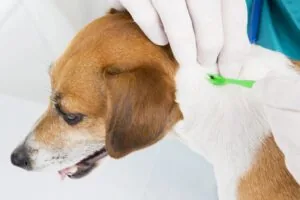Ear Mites
Is your pet itching his or her ears all the time? Do you see excess black debris in the ears? If you do, this may be a sign of ear mites. They are also very contagious, so quick diagnosis and treatment is essential to avoid spreading mites to other pets in your home or neighborhood. The treatments for ear mites have improved over the years and they are also easy to prevent.
What are ear mites?
Ear mites are parasites that live in the ear canal of animals. The most commonly seen species in veterinary practice is Otodectes cynotis, highly contagious, ear mites are a common cause of many ear problems in cats and, less commonly, in dogs. Ear mites appear as tiny white dots moving around in the ear canal.
It takes approximately 3 weeks for a mite to develop from an egg to an adult, going through a total of 5 stages. Adult ear mites live about 2 months, during which time they continually reproduce. The entire ear mite life cycle takes place on the host animal, although mites can survive for a limited time in the environment.
What are the clinical signs of ear mites?
Clinical signs of infestation vary in severity from one pet to another and include combinations of:
- Ear irritation causing scratching at the ears or head shaking
- A dark waxy or crusty discharge from the ear
- Areas of hair loss resulting from self-trauma – scratching or excessive grooming
- A crusted rash around or in the ear
- An aural hematoma – a large blood blister on the ear, caused by rupture of small blood vessels between the skin and cartilage – caused by scratching at the ears
- Skin lesions most frequently affect the ear and surrounding skin but occasionally other areas of the body may be affected.
Diagnosis
Diagnosis commonly is made by using a cotton-tipped applicator to take a sample of the debris in the ear canals. The material then is viewed in mineral oil under a microscope to determine if mites are present. Other ways of diagnosing ear mites include looking into the ears with an otoscope to identify mites visually. The light from the otoscope warms up the mites so that they can be seen crawling around. Skin scrapings, performed by using a dull blade gently to scrape the skin, sometimes are helpful to determine the presence of mites on other parts of the body.
Treatment
Treatment starts with a very thorough cleaning of the ears to get all the debris and wax out of the canals. If the ears are not properly cleaned, mites can survive the treatment because the wax and debris protects them. Your veterinarian will advise you about which insecticidal products are suitable. There are several ear medications licensed for the treatment of ear mites in pets. No medication can penetrate the eggs or pupae, so treatment is directed at killing the adult and larval forms. A variety of different treatment options are available to your veterinarian. Some are daily topical medications, while others may be injections (e.g., ivermectin), or single-use products such as Milbemite®, Revolution®, Advantage Multi®, Simparica® or Bravecto®. Your veterinarian will determine what the most appropriate treatment may be given the situation and your preferences. There are no products licensed for use in the house or on an animal’s skin, but many products licensed for flea control are effective.
Your veterinarian may want to re-examine your pet to ensure that the mites have been eliminated after the initial treatment has been performed.
Prevention
Effective prevention requires proper medical treatment of all animals that have mites, or that have been in contact with animals carrying mites. The use of an effective flea control product that stays on the animal for several days helps to control the spread of mites to other parts of the body. Disinfecting the environment with appropriate insecticides also is very helpful. Consult a veterinarian about the use of safe insecticides in the animal’s environment.
Share This Post
Recent Posts
About Shallowford Animal Hospital
Shallowford Animal Hospital and The Pet Spa at Shallowford are dedicated to the exceptional, compassionate care your pet deserves. Pets hold a very special place in our families, and we treat yours like our own.



